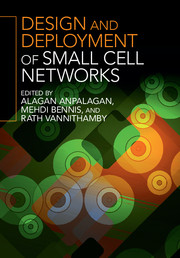Book contents
- Frontmatter
- Contents
- List of contributors
- Preface
- 1 Mobility performance optimization for 3GPP LTE HetNets
- 2 Design and performance analysis of multi-radio small cell networks
- 3 Dynamic TDD small cell management
- 4 3GPP RAN standards for small cells
- 5 Dense networks of small cells
- 6 Traffic offloading scenarios for heterogeneous networks
- 7 Required number of small cell access points in heterogeneous wireless networks
- 8 Small cell deployments: system scenarios, performance, and analysis
- 9 Temporary cognitive small cell networks for rapid and emergency deployments
- 10 Long-term evolution (LTE) and LTE-Advanced activities in small cell networks
- 11 Game theory and learning techniques for self-organization in small cell networks
- 12 Energy efficient strategies with BS sleep mode in green small cell networks
- 13 Mobility management in small cell heterogeneous networks
- 14 The art of deploying small cells: field trial experiments, system design, performance prediction, and deployment feasibility
- 15 Centralized self-optimization of interference management in LTE-A HetNets
- 16 Self-organized ICIC for SCN
- 17 Large-scale deployment and scalability
- 18 Energy efficient heterogeneous networks
- 19 Time- and frequency-domain e-ICIC with single- and multi-flow carrier aggregation in HetNets
- Index
- References
9 - Temporary cognitive small cell networks for rapid and emergency deployments
Published online by Cambridge University Press: 05 December 2015
- Frontmatter
- Contents
- List of contributors
- Preface
- 1 Mobility performance optimization for 3GPP LTE HetNets
- 2 Design and performance analysis of multi-radio small cell networks
- 3 Dynamic TDD small cell management
- 4 3GPP RAN standards for small cells
- 5 Dense networks of small cells
- 6 Traffic offloading scenarios for heterogeneous networks
- 7 Required number of small cell access points in heterogeneous wireless networks
- 8 Small cell deployments: system scenarios, performance, and analysis
- 9 Temporary cognitive small cell networks for rapid and emergency deployments
- 10 Long-term evolution (LTE) and LTE-Advanced activities in small cell networks
- 11 Game theory and learning techniques for self-organization in small cell networks
- 12 Energy efficient strategies with BS sleep mode in green small cell networks
- 13 Mobility management in small cell heterogeneous networks
- 14 The art of deploying small cells: field trial experiments, system design, performance prediction, and deployment feasibility
- 15 Centralized self-optimization of interference management in LTE-A HetNets
- 16 Self-organized ICIC for SCN
- 17 Large-scale deployment and scalability
- 18 Energy efficient heterogeneous networks
- 19 Time- and frequency-domain e-ICIC with single- and multi-flow carrier aggregation in HetNets
- Index
- References
Summary
This chapter introduces the concept of temporary cognitive small cell networks (TCSCN) as a supplement infrastructure to LTE-Advanced macro networks, and examines how the cognitive capabilities can enable the rapid and temporary nature of such deployments. Temporary networks are suitable for disaster-recovery scenarios where the nominal macro network is severely affected or completely paralyzed. In addition to that, such temporary networks can address the sudden increase in wireless traffic in certain geographic areas due to public events. The approach in realizing the cognitive capabilities is achieved by exploiting the latest LTE-Advanced HetNet features, as well as by presenting novel techniques for intelligently mitigating interference between the macro network base stations and the introduced temporary infrastructure. Simulation results are presented in order to show the enhancement of the wireless service when such temporary networks are deployed together with the proposed cognitive capabilities. At the end of this chapter an overview will be provided about open research directions that are fundamental for further possible realization of temporary cognitive small cell networks.
Introduction
The recent developments in broadband wireless networks have added an unprecedented level of reliability and bandwidth efficiency to the cellular communications, leading to the emergence of new user applications that would not be possible without such enhancements. In fact, commercial wireless networks are nowadays an irreplaceable gear in modern economies and societies, not only used for voice and video communications but also as a carrier for many mission-critical businesses and applications, such as wireless video monitoring, transportation signals, logistics tracking, and automatic power meter reading.
With this increasing dependency on telecommunication networks, the total failure of the economic system and public services would be massive if such networks are disrupted by means of a natural disaster such as a flood, earthquake, or tsunami, or by man-made attack. Among critical users of telecommunication networks are public safety agencies that are progressively depending on broadband telecommunication, making the need for providing a reliable broadband wireless service one of the top priorities for both commercial and public safety network operators.
Temporary small cells are seen as one of the viable solutions assisting network operators in tackling a sudden disruption of the wireless service, or a sudden increase in service demand generated by public events. These events include the potential move of the crowd, generating a heavy demand on cellular network capacity.
- Type
- Chapter
- Information
- Design and Deployment of Small Cell Networks , pp. 191 - 212Publisher: Cambridge University PressPrint publication year: 2015
References
- 2
- Cited by



